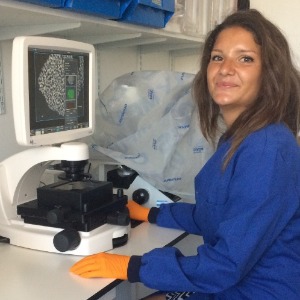Jun 24, 2019
Thawing of human pluripotent stem cells
- 1University of Edinburgh

Protocol Citation: Ralitsa R Madsen 2019. Thawing of human pluripotent stem cells . protocols.io https://dx.doi.org/10.17504/protocols.io.4pjgvkn
Manuscript citation:
License: This is an open access protocol distributed under the terms of the Creative Commons Attribution License, which permits unrestricted use, distribution, and reproduction in any medium, provided the original author and source are credited
Protocol status: Working
We use this protocol and it's working
Created: June 24, 2019
Last Modified: June 24, 2019
Protocol Integer ID: 25035
Keywords: pluripotent stem cells, thawing, cell culture
Abstract
This protocol describes the thawing of human pluripotent stem cells.
Guidelines
Abbreviations:
E8/F: Essential 8 Flex
DMEM/F12: Dulbecco’s Modified Eagle’s Medium/Nutrient Mixture F-12 Ham
This protocol is for thawing of human pluripotent stem cells frozen as clumps (size 50-200 μm). It can also be adapted for thawing of human pluripotent stem cells frozen as single cells.
Materials
MATERIALS
Essential 8 Flex Medium KitThermo Fisher ScientificCatalog #A2858501
Geltrex LDEV Free hESC Quality 5 mlThermo Fisher ScientificCatalog #A1413302
DMEM/F12 w/o L-Glutamine HEPES 500 mlSigma AldrichCatalog #D6421-500ML
RevitaCell Suppplement 100XThermo Fisher ScientificCatalog #A2644501
Nunc™ Delta Cell-Culture Treated Multidishes; 6-wellThermo Fisher ScientificCatalog #140685
Other materials (all sterile):
Filter tips (P1000)
Stripettes
Aspirator and aspirator tips
Benchtop microcentrifuge
Swinging bucket centrifuge
15 ml Falcon tubes
50 ml Falcon tubes
Safety warnings
It is essential to work as sterile as possible because the current protocol does not include use of antibiotics. Make sure to spray all surfaces and equipment with detergent and ethanol. Gloves should be changed frequently and sprayed with ethanol every times they have been outside the hood for more than 30 minutes or touched potentially contaminated surfaces/liquids.
Before start
Make sure to have
- Thawed E8/F supplement in the fridge overnight; or at room temperature away from light just before use.
Prepare media reagents and plates for seeding
Prepare media reagents and plates for seeding
Prepare the complete E8/F medium: transfer 10.2 ml of the thawed 50X supplement to 500 ml of E8/F basal medium. Mix well and write date of reconstitution. The medium is stable for 14 days if kept in the fridge.
NEVER warm the stock medium in a waterbath.
2m
If the cells were frozen from 1/2 or 1/3 of a subconfluent (80-90 %) 6-well plate, they will need to be thawed into 1 or max 2 wells of a Geltrex-coated 6-well plate (number of wells might require empirical optimisation based on knowledge about the particular cell line's behaviour).
Therefore prepare the required amount of E8/F medium in 50 ml Falcon tubes (always make aliquots so that the stock bottle of medium can be kept in the fridge - max 14 days following supplementation).
Supplement the aliquot with RevitaCell Supplement (this needs to be thawed in the dark in advance and aliquotted into smaller aliquots of 500 μl - stored at -20C).
As an example how to dilute RevitaCell (100X) in E8/F: add 500 μl of RevitaCell to 50 ml of E8/F; mix well and label as E8/F+R.
Make sure to have both E8/F and E8/F+R aliquots ready.
Allow the medium to equilibrate to room temperature before use. Do not keep out at room temperature for more than 3 hours without using. It is also a good idea to switch the safety cabinet light off if not in use so that the medium with RevitaCell is not exposed to light.
At the same time, take Geltrex-coated plates out to equilibrate at room temperature minimum 30 minutes before use. For coating, see:
Protocol

NAME
Coating of plates with Geltrex, for human iPSC cultureCREATED BY
Ralitsa R Madsen
30m
4 °C
Thaw one tube of Geltrex (1-5 mL) slowly at 2-8°C.
Prepare 20X 1.5 ml Eppendorfs for aliquotting of Geltrex, label: 50X
Mix Geltrex by slowly pipetting solution up and down; be careful not to introduce air bubbles.
On ice: in a 15 ml Falcon tube, mix Geltrex 1:1 with cold DMEM/F12 (Sigma #D6421) and aliquot at 0.5 ml.
Store the aliquots at -20C.
(REMEMBER TO CHECK EXPIRY DATE ON EVERYTHING)
Take plates that require coating and label.
Thaw an aliquot of Geltrex/DMEM/F12 (1:1 mix) on ice.
Prepare an aliquot of 22 ml cold DMEM/F12 = keep on ice. 4 °C
On ice: Dilute 450 ul of 1:1 Geltrex (50X) ~1:50 into 22 ml cold DMEM/F12 medium for a final dilution of 1:100. Empirical determination of the optimal coating concentration for your application may be required. Volumes can be adjusted accordingly.
Add a sufficient amount of diluted Geltrex solution to cover the entire area onto growth surface (100 ul/well in 96-well plate; 0.5 ml/well for 24-well and 4-well Ibidi imaging dish; 1 ml for 35 mm dish, 3 ml for 60 mm dish, i.e. 0.14 ml/cm2 --> 1 ml per 6-well dish; 8 ml per T75 flask).
Coat the dish and place in incubator (37C) for 60 min (no need to seal). 37 °C
Afterwards, take the plates that you will need for cell seeding out to room temperature for minimum 30 min. Store the remaining plates at 4C for up to 2 weeks (best for only 1 week to be on the safe side; parafilm to avoid drying out).
Do not allow coated surface to dry out and maintain a storage temperature of 2 to 8°C to avoid premature gelling. 4 °C
At time of use, aspirate GeltrexTM coating and immediately plate cells in pre-equilibrated cell culture medium. No rinsing!
Thaw the cells
Thaw the cells
Prepare 2x Falcon tubes (15 ml) per cell line; these will be used to avoid double-dipping into the working medium aliquot during cryovial washes.
Add 5 ml of E8/F (Revita not needed) to each one of the tubes.
Transfer the cryovial into the cell culture incubator at 37 °C Incubator, NOT waterbath and leave for 00:05:00 (approximately) minutes until a single ice lump remains. Do not use waterbath to avoid contamination! Alternatively, squeeze tight in your hands until a single ice lump remains.
Gently mix 1 ml E8/F from one of the 15 ml Falcons to the cryovial with thawed cells, taking care not to spill over. Transfer the suspension to one of the 15 ml Falcons. Using the same pipette, transfer medium from the 15 Falcon without cells to the cryovial to rinse any remaining cells off and combine with the cell suspension. Mix with the remaining medium in the Falcon without cells. The final volume in the 15 ml Falcon with cells should be 11 ml; discard the empty Falcon tube.
Note
NB: Very important to be gentle and avoid overpipetting. Failure to do this properly may compromise the quality of the cells and result in increased differentiation.
All medium should be added very slowly to the thawed cells to avoid osmotic/temperature shock. Try to rock/swirl the Falcon tube in between your fingers while adding medium to the cells in the specified mixing steps.
ONLY use stripettes to handle the cells at this stage. They are very fragile and using filter pipette tips will result in high shear stress and potentially break the clumps up too much.
3m
Centrifuge the cells for 3 minutes at 200 x g .
3m
Aspirate the supernatant, leaving only 100-200 μl behind. Gently flick the tube to resuspend the pellet.
Gently resuspend the cells in the required volume of E8/F+R for seeding into either one or two 6-wells, calculating for 2 ml per 6-well.
Note
NB: Essential to be gentle, yet resuspend the cells sufficiently to make sure that the clumps are of the right size. This becomes easy to see by eye with some practice. Otherwise, assess clump size under the microscope following seeding and refine if necessary.
1m
Aspirate the residual Geltrex liquid from the coated wells and add the required volume of cell suspension to each well. Check under the microscope that the clumps have the right size (50-200 μm) - the RevitaCell enables cell survival as single cells, so it is more important to get most clumps below 200 μm than to avoid single cells. If required, break the clumps up further using P1000, but be gentle when pipetting (usually 3-4 times of gentle pipetting is enough). If you deem the cells to be too sparse, consider pooling into a single well (when in doubt in such cases, start by resuspending the cell pellet in the previous step in 3 ml medium, then seed 1.5 ml of the suspension into each one of two wells, assess under the microscope and decide whether to pool into a single well in a final volume of 3 ml).
5m
Return the cells to the incubator 37 °C and assess 24h later (try to keep a routine schedule where cells are handled at roughly the same time of day). Make sure to distribute the cells evenly across the well by moving the plate up-down-left-right when in the incubator.
Note
It is important that the cells are left undisturbed when thawed so they can settle properly.
Replenish with fresh E8/F (2 ml per 6-well) medium the next day; NB: NO Revita (but only if the cells/colonies look sufficently large and healthy, otherwise replenish with E8/F+R for another 24h).
Note that once Revita is removed, the colonies will exhibit signs of stress on the following day, with several colonies appearing apoptotic and perhaps detaching. This should normalise and the cells should be ready to split again 4-5 days later when 70-90 % confluent (ideally 80 %).
The splitting ratio for each line will have to be determined empirically, but usually the first split after thawing has to be gentler than usual.
The image is representative of iPSCs 2 days post-thawing and 24h following RevitaCell removal. Magnification = 100X, scale bar = 400 μm.
Example image of iPSC cultures 5 days post-thaw when ready to be split. This usually easy to see from the colour of the medium which should be orange-yellowish despite daily replenishment. In this case, the cells are actually much dense at the edges (see image below), which typically happens when the cells have experienced stress. It is therefore important to assess the density across the entire plate. As a rule of thumb, a plate should be split when most colonies reach a diameter > 1000 μm and the medium is orange-yellowish despite exchange on the previous day. Magnification = 40X, scale bar = 1000 μm.
Image of the same culture as shown above but taken from the edge of the well, showing higher density which is typically when the cultures have been struggling, as is typical after thawing. Magnification = 40X, scale bar = 1000 μm.
1m
